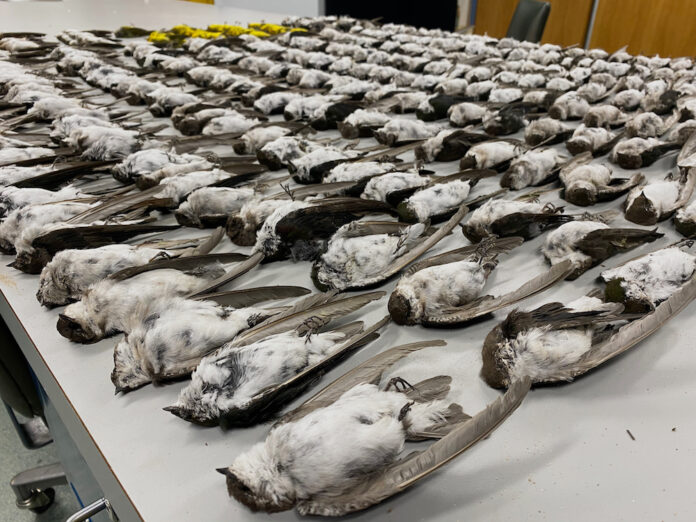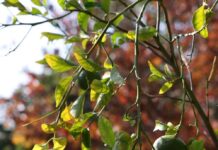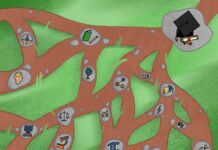
In search of dead birds, doctoral ornithology students at the University of New Mexico Nick Vinciguerra and Jenna McCullough arrived in Velarde, NM at midnight Sept. 14. They carried headlamps and plastic bags but were not sure exactly what to expect, Vinciguerra said. Their trip to Velarde had been prompted by a video of dozens of dead swallows in the area and widespread reports of bird casualties across the state.
“We got there, we hiked up. We saw one dead bird, and, it was like ‘Well, that’s it’ — and then, sure enough, after that we turned the corner and there were hundreds of [dead] birds along the bank and in the cavities,” Vinciguerra said. “Huddled up along the bank, some were in the reeds and strewn out across the grass along the bank. It was a macabre scene.”
According to Vinciguerra, he and McCullough collected 305 dead birds that night, filling six plastic bags. They quickly bought ice at the local gas station to freeze the birds and brought the specimens to the Museum of Southwestern Biology to examine them.
Every autumn, migratory birds fly from their breeding locations in the north to their wintering grounds in the south. This September, approximately hundreds of thousands of birds were unable to complete their migration, dying in large numbers in the Southwestern Rocky Mountain states, according to John McCormack, the director and curator of Occidental’s Moore Lab of Zoology. Vinciguerra conducted research at the Moore Lab with McCormack in 2014.
Vinciguerra and McCullough researched the cause of this die-off using the specimens they collected in Velarde, NM. They concluded that the event was likely caused by unusually cold weather which killed off the birds’ food supply and induced hypothermia.
At the lab in New Mexico, Vinciguerra and McCullough emptied their plastic bags, weighed the birds, examined the specimens’ overall condition and sorted them by species. The majority of the birds were Violet-green Swallows, but there were also a significant number of Wilson’s Warblers and a small number of additional species. According to Vinciguerra, since they collected a large sample size of Violet-green Swallows, he and McCullough were able to use an open-access museum collections database called Vertnet to compare the data from the birds they collected to specimens that were collected previously and housed in museums across the U.S.
“We noted that the birds we collected were two-thirds the weight of healthy birds of the same species, suggesting that this cold snap had brought on some level of starvation,” Vinciguerra said.
According to Vinciguerra, all of the species he and McCullough collected were insectivores. Swallows are aerial insectivores, meaning they feed on the wing and are particularly vulnerable to insect shortages.
“It was just record-breaking in every sort of [weather] dimension you can think of,” Vinciguerra said. “We had cold weather, including snow and high winds, and that all has an impact on the insects.”
According to McCormack, there has also been speculation about the influence the California wildfires might have had on migratory bird populations and their migration patterns, though evidence currently points to cold weather as the most significant cause. According to Vinciguerra, while the bird specimens he examined did not show signs of fire-related mortality, it is possible the smoke might have had an internal effect on the birds. Some of the birds collected in Velarde have been sent to forensic labs to conduct toxicology tests and necropsies to determine whether the birds were affected by smoke, but it could take several months until they receive results, Vinciguerra said.
“We’re living in an ever-changing human–dominated world where these kinds of [extreme weather] events are occurring more frequently and with much more intensity,” Vinciguerra said. “It’s really important for us to document these events so we have a time record of when and where these things happened. We can start looking at patterns and trends in the data, and that’s where museum specimens are critically important.“
By collecting specimens, scientists are able to record when and where mortality events happen and the genetic data of the animal. Using this data together, scientists can start looking at patterns and trends in the data, Vinciguerra said.
“With the museum specimen, we have information on ecology, morphology, geography and genetics,” Vinciguerra said. “We can tie all those things together to look at how these events have shaped the evolutionary patterns and processes that we see.”
According to McCormack, the Moore Lab research focuses on using bird specimens to understand and explain global planetary change.
“What people don’t realize often when they go into the Moore Lab and they see what can sometimes seem like just a lot of dead birds, is that there is information there about the health of our planet,” McCormack said.
According to McCormack, because migratory birds depend on many different habitats in many different places, they are a useful indicator for the health of the environment.
“There’s that old saying of the canary in the coal mine, and there are a lot of reasons to think that birds really are leading indicators of our planetary health,” McCormack said. “When something gets disrupted, whether it’s with the weather or the seasonal cycles or habitat destruction in any one of these places, you begin to see that impact first in migratory birds.”
According to Vinciguerra, while this specific mortality event is unfortunate and has an impact on the bird population, the ultimate threat to birds is habitat loss, destruction and modification.
“All of the factors that have been hypothesized to play a role in this die-off can be tied back to climate change,” Vinciguerra said. “I think this event needs to be documented, it needs to be talked about and it needs to be taken seriously.”
According to Michael Long, a board member of the Pasadena Audubon Society and a retired employee of the Los Angeles County Parks Department, one easy way people can help birds in their area is by putting out water for them. People should make sure there aren’t any mosquitoes in the water and replace it at least every three days. Long also said he encourages participation in the Audubon Society’s conservation efforts.
“Birds always eventually lead you to conservation,” Long said.
McCormack said he encourages anyone who sees a dead bird on campus that is in relatively good condition to contact the Moore Lab so they can collect the specimen.
“You might just think of that as just a dead bird on the ground, but actually it is potentially a very valuable data point,” McCormack said.
This article was revised Oct. 14 at 4:42 p.m. to clarify Vinciguerra said that extreme weather events were occurring more frequently, not die-off events.
This article was revised Jan. 25 at 12:10 p.m. to clarify the difference between weather and climate in a quote from Vinciguerra
![]()


































